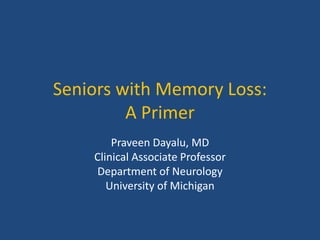
Mon 10-20 Seniors with Memory Loss- A Primer_0.pptx
- 1. Seniors with Memory Loss: A Primer Praveen Dayalu, MD Clinical Associate Professor Department of Neurology University of Michigan
- 2. Cognitive domains • Executive function (frontal, hemispheric white matter) • Memory (medial temporal lobes/ hippocampus) • Language (left hemisphere, usually) • Visuospatial (occipital, parietal)
- 3. Cerebral hemisphere and lobes
- 4. What Is Dementia? • Impairment in intellectual function affecting more than one cognitive domains • Interferes with social or occupational function • Decline from a previous level • Not explained by delirium or major psychiatric disease 4
- 5. Mild Cognitive Impairment • Cognitive decline abnormal for age and education but does not interfere with function and activities • “At risk” state to develop a degenerative dementia • When memory loss predominates, termed Amnestic MCI. This has ~15% per year of conversion to AD. 5
- 6. Cognitive decline Depression Other psych Delirium Drug induced Dementias (“big four”) Alzheimer Vascular Lewy body / PD Frontotemporal Alcohol Recreational Prescriptions ! Many causes! Alone, or With dementia Trauma, tumor, MS, HIV, syphilis, NPH, subdurals, vasculitis, CJD Hepatic, renal, or thyroid disease Deficiency (B12) Toxins, OSA
- 7. “Primary” dementias: the big ones • AD= Alzheimer’s • LBD= Lewy Body dementia • PD= Parkinson disease dementia • FTD= Frontotemporal dementia • Vascular
- 8. Alzheimer Disease (AD) • Commonest neurodegenerative and dementing disease • Prevalence doubles every 5 years after 65; ~50% of those older than 85 8
- 9. AD Risk Factors • Age!! • Mild cognitive impairment (MCI) • ApoE-e4 positivity • Family hx in first degree relative (especially if younger onset) • Vascular risk (diabetes, heart disease, etc.) • Low education and physical/social activity • Female sex 9
- 10. Mild-moderate AD Severe AD 10
- 11. AD Clinical Features • Earliest cognitive symptoms are usually poor short term memory; loss of orientation • Smooth, usually slow decline without dramatic short-term fluctuations • Other domains involved with time • So common that many variations are seen 11
- 12. AD: Behavioral & Psych • Depression, anxiety • Irritability, hostility, apathy • Delusions, hallucinations • Sleep-wake changes • Sundowning • Agitation 12
- 13. Dementia with Lewy Bodies (DLB) • Relatively earlier occipital and basal ganglia degeneration • Similar to Parkinson disease dementia • α-synuclein aggregates into Lewy bodies • Concurrent AD pathology is common 13
- 14. DLB Clinical Features Dementia (early on, visuospatial and executive) PLUS • Core features Parkinsonism Recurrent early visual hallucinations Fluctuations (clue: recurrent delirium evaluations) • Suggestive features include REM sleep disorder (dream enactment) & neuroleptic sensitivity 14
- 15. Frontotemporal Dementia (FTD) • Average age of onset 58, rather than very old • Often familial (30-50%) • Overlap with progressive supranuclear palsy, ALS, and corticobasal degeneration • Pathologic aggregates of tau or TDP-43 15
- 16. FTD clinical features • Behavior and personality change (may be initially misdiagnosed as a psychiatric disorder) • Executive dysfunction • Progressive non-fluent aphasia • May see parkinsonism or muscle weakness 16
- 17. Vascular Dementia • Suspect when Abrupt onset and/or stepwise decline Fluctuating course H/o stroke Focal neurologic symptoms or signs • Usually see bilateral infarcts • Often associated with executive dysfunction, gait disorder, apathy, incontinence 17
- 18. “...evidence of chronic small vessel ischemic disease involving subcortical white matter” • This is nondiagnostic and very common with age • Changes may or may not be symptomatic • ≠ “Vascular dementia” • Don’t tell patients “Your scan showed strokes.”
- 19. Cognitive decline Depression Other psych Delirium Drug induced Dementias (“big four”) Alzheimer Vascular Lewy body / PD Frontotemporal Alcohol Recreational Prescriptions ! Many causes! Alone, or With dementia Trauma, tumor, MS, HIV, syphilis, NPH, subdurals, vasculitis, CJD Hepatic, renal, or thyroid disease Deficiency (B12) Toxins, OSA
- 20. The HPI is critical ! • Ask a close informant • Duration, rate, smoothness? • Associated symptoms (headache, trouble with vision, speech, strength, coordination, gait) • What domains are affected? Repeats self? Forgets recent things? Appointments? Month & year? Trouble with appliances? Trouble planning? Change in personality, judgment, behavior? Navigation problems? Hallucinations? Word finding problems? • How is function affected? Finances, chores, hobbies, driving, occupation, social
- 21. Fill out the picture • Medical problems and risk factors? • Neurologic history (stroke, trauma, infection)? • Educational background? • Family history? • Alcohol and drugs? • Medications? Remember, your first goal is to exclude readily treatable causes…
- 22. Differential diagnosis in dementia: Commoner treatable causes • Structural brain lesion (subdural bleed) • Thyroid disease • B12 deficiency • Untreated sleep apnea • Depression or anxiety • Alcoholism • Meds: Benzos, opioids, anticholinergics (diphenhydramine, bladder drugs, tricyclics), neuroleptics, dopaminergics, other sedatives
- 23. Examination • General neurologic exam Any focalities that suggest stroke? Signs of parkinsonism or a gait disorder? • Cognitive screen Mini-mental (MMSE) Mini-cog Montreal Cognitive Assessment (MoCA)
- 24. Holsinger et al JAMA. 2007;297(21):2391-2404
- 25. Diagnostic testing • There is no “dementia test panel” • For slowly progressive “typical” dementia in adults >65, most essential tests: B12, TSH, brain image (CT is ok) • Neuropsychology testing can help but not mandatory • FDG- PET approved to differentiate AD from FTD • Amyloid-PET has just been approved • PET studies have little value in most cases and are expensive • For younger patients, or rapid or atypical course, workup may be “tiered” to target range of diagnoses, emphasizing treatable causes 25
- 26. Why properly diagnose? • There may be a readily treatable cause • Some degenerative dementias do have symptomatic pharmacotherapies • Patients and families want to know and understand what they are dealing with • Helps long-term planning • Facilitates research efforts • Facilitates advocacy/ support group participation
- 27. Drug treatment? • No current treatment slows down neuronal loss in the brain • Cholinesterase inhibitors (donepezil, rivastigmine, galantamine)? - Modest symptom improvement in AD - Sometimes marked improvements in PDD/ DLB • Memantine? Modest benefit in AD
